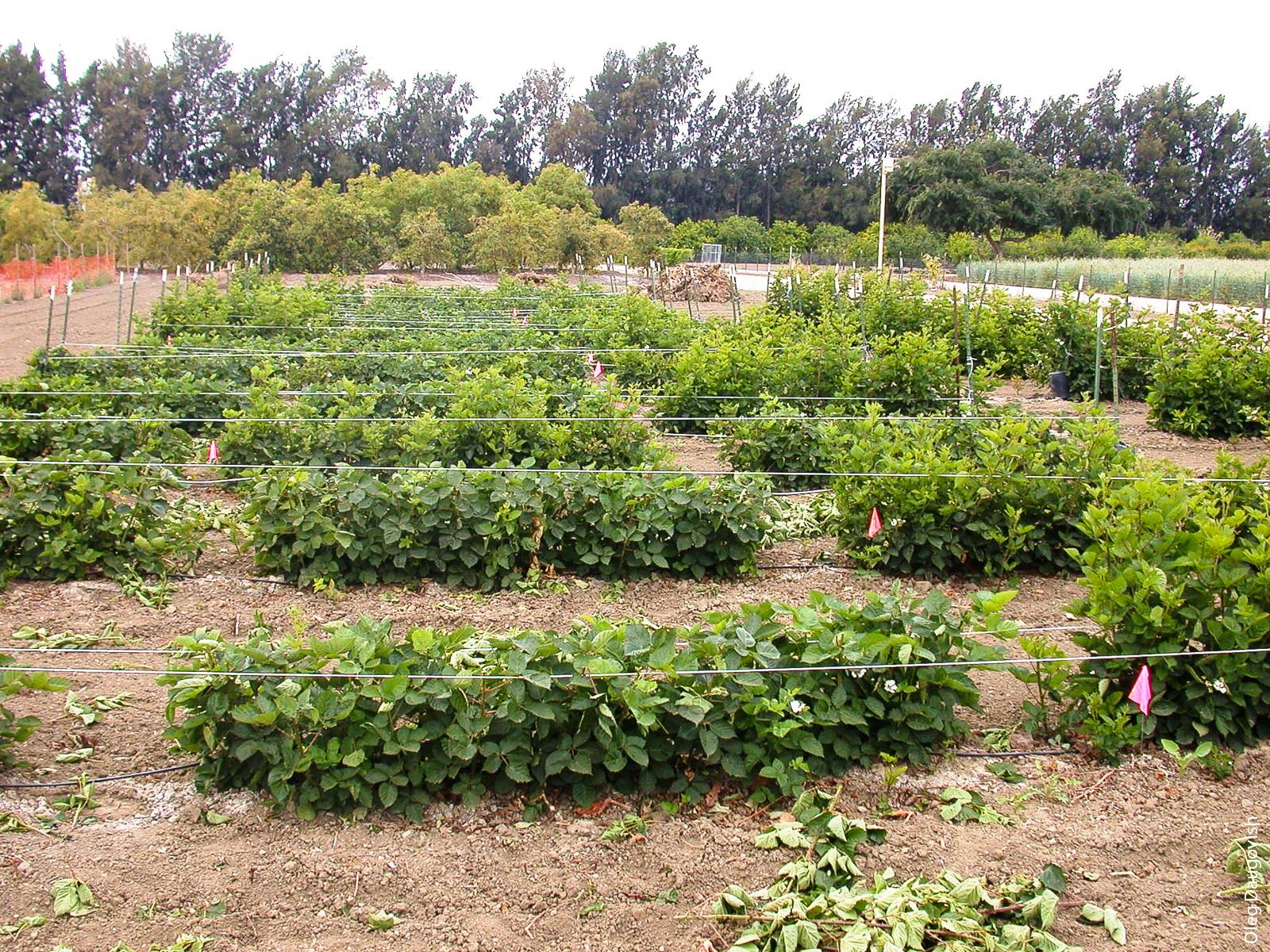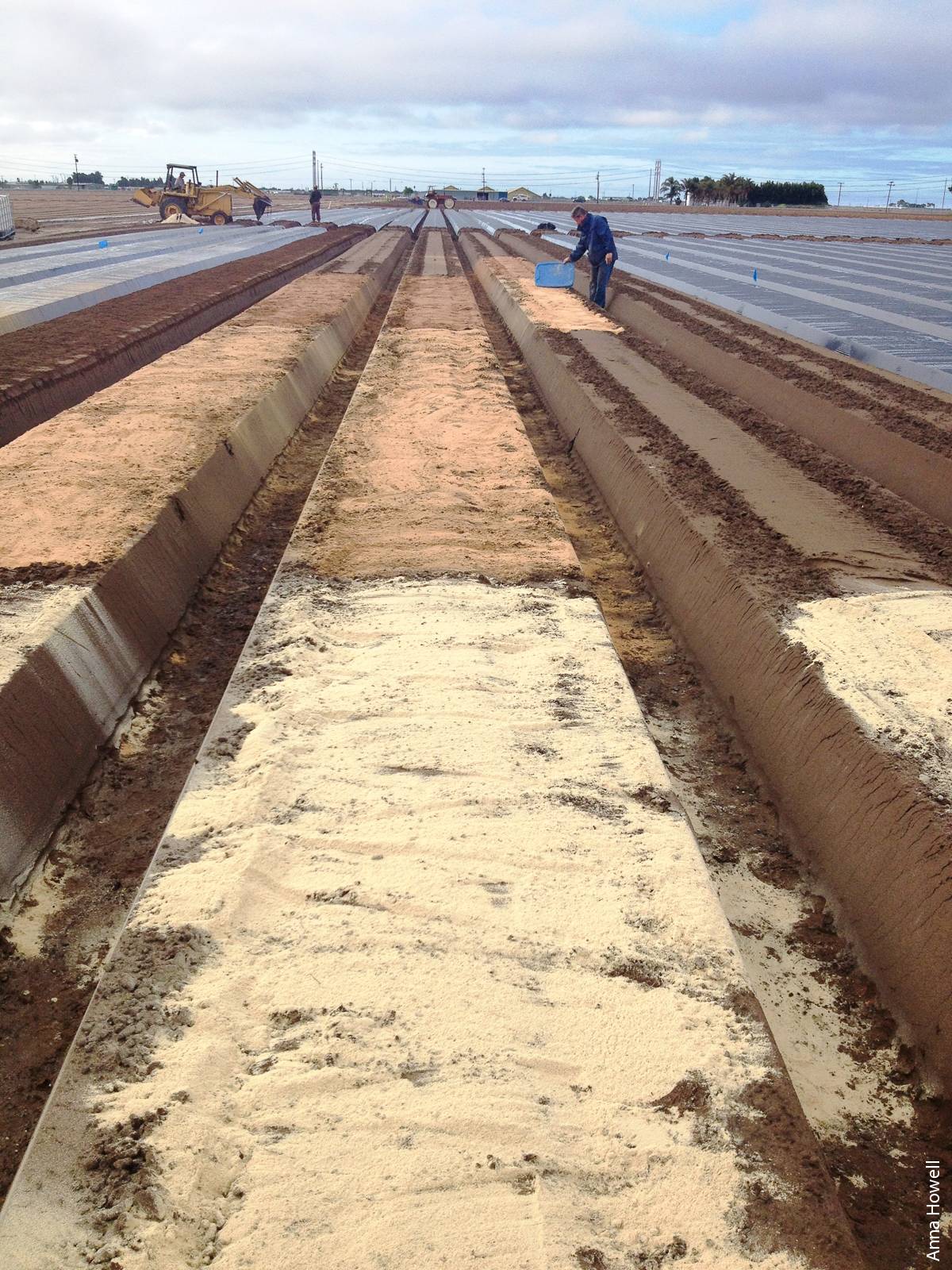All Issues
At Hansen Agricultural REC, better blackberries and a soil disinfestation alternative
Publication Information
California Agriculture 70(3):104-106. https://doi.org/10.3733/ca.2016a0010
Published online August 01, 2016
Full text
At 27 acres, Hansen Agricultural Research and Extension Center (HAREC), in Ventura County, is small. It is exposed to the Santa Ana winds and has heavy clay loam soil infested with one of the highest levels of Verticillium wilt fungus recorded anywhere in the state. And yet it's proving a major resource for Central Coast growers interested in producing a very profitable blackberry crop or in managing soil pests in strawberries without fumigation.
HAREC has developed a growing program for a firm, sweet, large blackberry to produce a good yield during a high-prices sales window in late summer and fall. UC Cooperative Extension (UCCE) Farm Advisor Oleg Daugovish, in charge of berry research, is also contributing to the international knowledge bank on anaerobic soil disinfestation (ASD), an alternative to chemical fumigation that uses waste carbon products, such as rice bran. Growers of high-value organic strawberries in the Central Coast region have taken up ASD enthusiastically.
Prime-Ark 45 blackberry
In fall 2011, a new, publicly available primocane blackberry variety, Prime-Ark 45, from the University of Arkansas fruit breeding program was planted at HAREC. “It looked good, tasted good, and yielded well,” Daugovish recalls. Since then he has established how to manipulate the timing of the harvest, working with UCCE researchers with blackberry trials under way in other parts of the coast: Mark Bolda, UCCE Director and Farm Advisor in Santa Cruz County, and Mark Gaskell, UC Small Farms Program Advisor in San Luis Obispo and Santa Barbara counties (Gaskell and Daugovish 2016). “Our results are consistent and add up to the same story,” says Daugovish. “This is a high-quality crop, easy to manage, and fruiting can be optimized for the lucrative window in late summer.”
Timing the California blackberry harvest for late summer, when berries from other sources are scarce, helps growers maximize returns.
The timing of the harvest is key, because until August, and after October or November, imports from Mexico are heavy and keep blackberry prices lower. Production of blackberries in Mexico expanded from 5,431 acres in 2004 to 27,195 acres in 2011 and is still expanding. Demand for blackberries in the United States has also increased significantly, especially on the West Coast and among younger people (21 to 39) and people with high incomes (GAIN 2013).
HAREC trials have established that a late mow-down of the canes, in January or February rather than December, and tipping canes in late April or early May to 45 centimeters (18 inches) result in the largest crop from August to October.
In blackberry trials at HAREC, researchers found that mowing the canes in January and tipping in May resulted in the largest crop from August to October.
Fertilization also increases yields substantially. In 2014, the plots were not fertilized, which resulted in poor growth and yields as low as 1.2 kilograms (2.6 pounds) per plant. Last year, 7 to 9 pounds of nitrogen per acre per week was applied using fertigation until 2 to 3 weeks before harvest, and the per-plant yields were about 2 kilograms (4.5 pounds), the heaviest crop seen since 2013.
In all seasons the marketable yields could have been almost double if not for the crop loss due to spotted wing drosophila. No pesticides were used during the growing season, and up to 60% of the fruit have been unmarketable during the warmest harvesting weeks. This year, Daugovish is using insect netting on tunnels with double-door entrances to test the effects of insect entry prevention on crop yield and returns. The light net cover will likely reduce sunburn and wind damage, which have been contributing to fruit losses at HAREC.
“There will be saturation in the blackberry market at some point,” says Daugovish, “but at present there's still room for expansion.” Growers might consider planting Prime-Ark Freedom, a newer variety from University of Arkansas, which is thornless. Daugovish hopes to plant it at HAREC and test other publicly available caneberry varieties.
Anaerobic soil disinfestation (ASD)
ASD research is particularly interesting because no one yet fully understands the complex interactions of ASD, only that it works. And it seems to work better the more years it is practiced, as if the suppression of pathogens is incremental or their effect becomes less aggressive as soil properties change and microbial populations shift over time.
Slightly more than 1,000 acres of commercial strawberries in the coastal counties were grown on land treated with ASD last year after 8 years of trials at HAREC, where the research began as a collaborative effort with UC Santa Cruz scientists. Daugovish is now running ASD optimization trials at HAREC and in grower fields, to make it easier and cheaper for growers to use.
The standard ASD treatment involves mixing 9 tons per acre of rice bran into the top 24 inches of soil just before strawberry beds are listed, in summer, covering the beds in plastic mulch (black or clear), applying irrigation until the soil is saturated (and anaerobic conditions are set) and waiting 3 to 5 weeks. Then the planting holes are cut through the plastic, and soil conditions become aerobic again.
The bran is a waste product from processing plants in the Central Valley; it is inexpensive but transportation costs are significant. Mixed into soil, it is a carbon source for soil microbes, which decompose it anaerobically. The goal is to suppress soilborne pathogens such as Verticillium dahliae, Fusarium oxysporum and Macrophomina phaseolina and to modify the soil environment to benefit plant growth. Daugovish estimates the ASD cost per acre with 9 tons of rice bran is about $3,000, but the bran also serves as preplant fertilizer (providing nitrogen and phosphorus), usually a $400 to $600 expense in organic systems.
In ASD treatment, rice bran is mixed into the top 24 inches of soil, which creates an anaerobic environment that helps to suppress soilborne pathogens such as V. dahliae and F. oxysporum.
Growers using ASD, mostly organic growers, have seen greatly increased yields. At HAREC, 1.2 pounds per plant were harvested from ASD-treated plots last year, a 52% improvement over yields from untreated checks. Organic growers using ASD have increased their yields 35% to 50% above the average non-ASD yield of 0.6 to 1 pound per plant in the Ventura area.
Joji Muramoto and Carol Shannon, at UC Santa Cruz, working with UCCE farm advisors Mark Bolda (Santa Cruz County) and Surendra Dara (San Luis Obispo and Santa Barbara counties), have similar trials under way. In replicated field trials in coastal counties in 2014, strawberry fruit yields after ASD treatments were almost identical to those obtained from standard chemically fumigated soils (Muramoto et al. 2014).
Last year, Daugovish established in one trial that irrigation could be delayed for 1 week, to give growers the necessary time for connecting and testing the irrigation lines. Even better, the trials suggested that irrigation might be unnecessary; the process worked in the heavy HAREC soils with the existing moisture in the soils after bed shaping. Optimizing or eliminating the irrigation step is significant: it would reduce growers’ water costs and the risk of nutrient leaching. This year, Daugovish has trials under way in growers’ fields on sandy soil, with no irrigation during ASD, and the results look promising.
Using drip-applied liquid glycerin, a byproduct of biodiesel processing in Kern County, as the carbon source last year didn't work as well as using rice bran; nor did spreading ground dry grape pomace, a byproduct from coastal wineries. Both resulted in significantly lower yields than were recorded in the rice bran plots. This year, Daugovish is trialing three more carbon sources, all free waste products from local industries: coffee grounds, brewery waste, and grass clippings from sod suppliers.
His goal is not only to find more carbon sources as effective as rice bran, but also to develop a bank of knowledge using various products. He is in touch with researchers in Japan and Spain, where strawberry growers have similar soil pest challenges, and ASD is known as pasteurization or biosolarization.
“It's the beginning of a new era,” says Daugovish, now that researchers have molecular tools to measure levels of some soil pathogens very rapidly and are developing tools for measuring levels of others. In place of a single successful blanket chemical treatment that killed everything (methyl bromide), a new soil science is developing that will measure real-time pathogen and microbial populations and perhaps require multiple layers of management — different varieties with different levels of disease resistance/tolerance, different soil treatments — in a single field. “Growing berries is going to be a different game in the years to come,” he says.
Local UC Master Gardener volunteers, who help harvest the berry crops at HAREC, understand the situation as much as anyone. During fruit harvests, Daugovish explains what's happening in his research trials and trials elsewhere. The Master Gardeners play an important role at HAREC, and Daugovish likes to hear their thoughts on how the work there translates into their own gardening practices, so they are all, together, part of something important, local and global.







